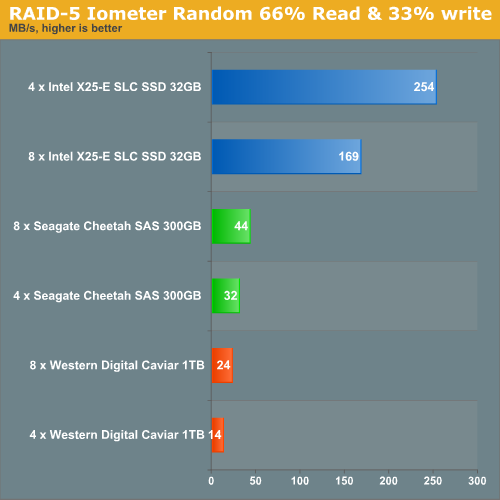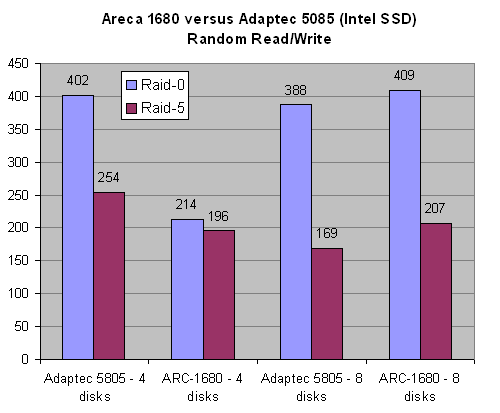SSD versus Enterprise SAS and SATA disks
by Johan De Gelas on March 20, 2009 2:00 AM EST- Posted in
- IT Computing
More RAID 5
The Random 66% read + 33% write is still the most interesting scenario, as it mimics an OLTP database.


While it is true that the Adaptec shows some bad scaling in RAID 0, both controllers fail to show any decent performance increase with more than four disks in RAID 5. This only confirms our suspicion: the SLC drives are capable of reading and writing at blazing speed, so the RAID controller is swarmed by the massive amount of reads per second that need to happen for each write. As the amount of reads for one write that need to happen on the eight drive array is more than twice the amount on the four drive array, performance decreases. This is not an issue with the magnetic disks, as they are performing the same task at much lower speeds and thus require much less reads per second. We may assume that the RAID controller is holding back the SSD array, but proof is better than conjecture. We attached the four drives to each controller and made the Xeon at 3.33GHz the RAID controller (i.e. software RAID in Windows 2003):
| RAID 5 with Eight X25-E SSDs | ||
| One IOP348 controller and Hardware RAID |
Two Controllers and Software RAID |
|
| Sequential Read | 688 MB/s | 1257 MB/s |
| Sequential Read/Write | 221 MB/s | 257 MB/s |
| Random Read/Write | 169 MB/s | 235 MB/s |
Once we use the Xeon as the storage processor, the bottleneck is gone (or at least less narrow). Sequential read performance is twice as high as with four disks, and although the scaling of random read/write performance is nothing to write home about (19%), at least it is not negative anymore.
Should we blame Adaptec? No. The bandwidth and crunching power available on our Adaptec card far outstrips the demands of any array of eight magnetic disks (the maximum of drives supported on this controller). You might remember from our older storage articles that even the much more complex RAID 6 calculations were no problem for the modern storage CPUs. However, the superior performance of the Intel X25-E drives makes long forgotten bottlenecks rear their ugly head once again.










67 Comments
View All Comments
shady28 - Sunday, November 15, 2009 - link
I would have really like to see single drive performance of SAS 15K drives vs SSDs. The cost of a SAS controller ($60) + a 15K 150Gig drive ($110-$160) is less than any of the high end SSDs, and about the same as a low end SSD. It's a viable option to get a 15K Drive, but very difficult to see what is the best choice when looking at RAID configs and database IOPs.
newriter27 - Tuesday, May 5, 2009 - link
What was the Queue Depth setting used with IOmeter? Was it maintained consistently?Also, how come no response times?
mikeblas - Friday, April 17, 2009 - link
Intel has posted a firmware upgrade for their SSD drives which tries to address the write leveling problem. The patch improves matters, somewhat, but the overall performance level from the drives is still completely unacceptable for production applications.You can find it here: http://www.intel.com/support/ssdc/index_update.htm">http://www.intel.com/support/ssdc/index_update.htm
Lifted - Sunday, April 12, 2009 - link
I like it!turrican2097 - Monday, March 30, 2009 - link
Please mention or correct this on your article.1) You should mention that the price per GB is 65x higher than the 1TB drives, since you chose to include them.
2) Your WD is a poor performance 5400RPM Green Power drive: http://www.techreport.com/articles.x/16393/8">http://www.techreport.com/articles.x/16393/8
3) If you make such a strong point on how much faster SSDs are than platters, you can't pick the best SSD and then use the hardrives you happen to have laying around the lab. Pick Velociraptors or WD RE3 7200RPM and then Seagate 15K7.
Thank you
mutantmagnet - Monday, April 6, 2009 - link
It's irrelevant. Raptors don't outperform SAS which are better in terms of performance for the GB paid for. There's no need to belittle them when they are clearly aware of the type of point you are making and went beyond it.So far I've found these recent SSD articles to be a fun and worthwhile read; and the comments have been invaluable, even if some people sound a little too aggressive in making their points.
virtualgeek - Friday, March 27, 2009 - link
Just wanted to point this out - we are now shipping these 200GB and 400GB SLC-based STEC drives in EMC Symmetrix, CLARiiON and Celerra. These are the 2nd full generation of EFDs.Gang - this IS the future of performance-oriented storage (not implying it will be EMC-unique - it won't be - everyone will do it - from the high end to the low end) - only a matter of time (we're currently at the point where they are 1/3 the acquisition cost to hit a given IOPS workload - and they have dropped by a factor of 4x in ONE YEAR).
With Intel and Samsung entering to the market full force - the price/performance/capacity curve will continue to accelerate.
ms0815 - Friday, March 27, 2009 - link
Since modern Graphic cards crack passwords more than 10 times faster than a CPU, wouldn't they also be greate Raid Controllers with their massive paralel design?Casper42 - Thursday, March 26, 2009 - link
I would have liked to have seen 2 additional drives tossed into the mix on this one.1) The Intel X25-M - Because I think it would serve as a good middleground between the SAS Drives and the E model. Cheaper/GB but still gets you a much faster Random Read result and I'm sure a slightly faster Random Write as well.
2) 2.5" SAS Drives - Because mainstream servers like HP and Dell seem to be going more and more this direction. I don't know many Fortune 500s using Supermicro. 2.5" SAS goes up to 72GB for 15K and 300GB for 10K currently. Though I am hearing that 144GB 15K models are right around the corner.
Thanks for an interesting article!
MrSAballmer - Thursday, March 26, 2009 - link
SDS with ATA!http://www.youtube.com/watch?v=x4dxTRkODbE">http://www.youtube.com/watch?v=x4dxTRkODbE
http://fakesteveballmer.blogspot.com">http://fakesteveballmer.blogspot.com